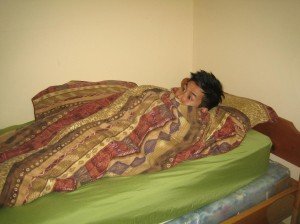Falls from a bed can occur among children, especially the young ones. Parents are well aware of the sound of a “clunk” in the night as a child strikes the floor after falling out of a bed.
Unless the child sleeps in the top bunk, falls from bed are usually not more than a few feet and rarely result to serious harm. Nevertheless, falls from a height higher than 3 feet can result to injury. Parents must be well aware of the signs of a possible injury from falls.
Changes in the vital signs
A child who sustained a head injury from a fall out of bed might turn pale or even bluish along with shallow, erratic breathing. Take note that vomiting once is common after a fall but if the episodes reach up to 3 times or more, it might be an indication of a head injury. In such cases, the child should be assessed by a doctor.

Behavioral changes after falls
Children who sustained head injuries from falls from the bed might lose consciousness. Passing out even for a short period must be carefully assessed by a doctor. Call for emergency assistance if the child stays unconscious.
When it comes to injuries from falls from a top bunk, they are considered as the most serious. Concussion and skull fractures occur most often among children who fall onto uncarpeted surfaces.
If a child sustained an internal head injury, he/she appears fine after the accident but might become progressively unresponsive, sleepy or lethargic. The child might complain of a severe headache or cry continuously if not old enough to verbalize what he/she feels. Any indication of an altered mental status entails immediate medical attention.
Visual changes
Children who endured falls from the bed and sustained a head injury might have evident visual changes. The eyes might cross or roll or move quickly from side to side.
In some cases, one pupil might appear dilated than the other. The older children might complain of blurry vision or double vision. The visual changes require careful assessment by the doctor.
Altered movement
When a child falls out of a bed, he/she might sustain a broken bone particularly the clavicle, but the legs and arms can also break. Difficulty or inability to move an extremity, pain during movement, swelling or abnormal position of the bone and limping can indicate a fracture.
The head injuries can also lead to loss of coordination in which the child can stagger, fall or unable to walk in a straight line. If you suspect any form of spinal or neck injury, do not attempt to move the child but call for emergency assistance.
Caring for wounds and bruises
A child who falls from the bed might be bleeding, especially if he/she drops onto an object on the floor. You have to check if the bleeding can be controlled, easily stops and not spurting from the wound.
The gaping wounds might require stitches and must be assessed by a doctor. Assess the child for bruising that might indicate an injury that might not be evidently present. A large-sized bruise on the forehead might appear unsightly but even the large ones are rarely serious. In addition, closely monitor for changes in the behavior and apply an ice pack on the bump.
